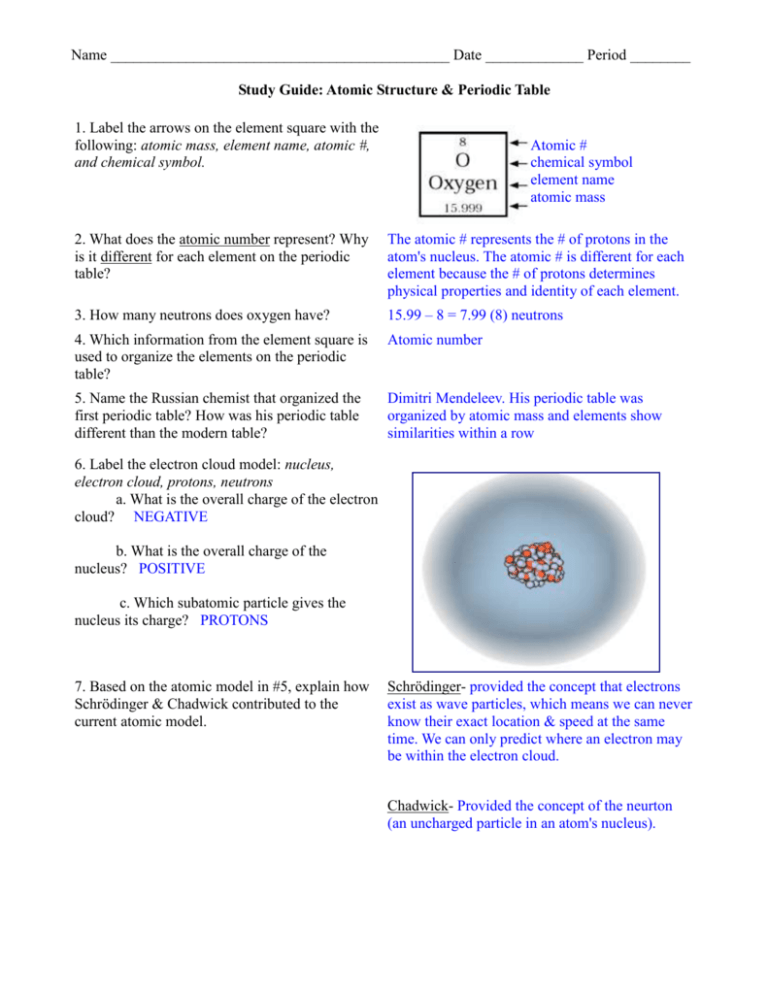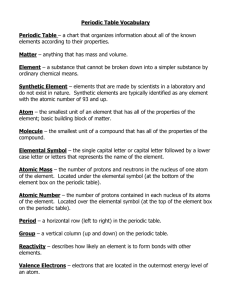File
advertisement

Name _____________________________________________ Date _____________ Period ________ Study Guide: Atomic Structure & Periodic Table 1. Label the arrows on the element square with the following: atomic mass, element name, atomic #, and chemical symbol. Atomic # chemical symbol element name atomic mass 2. What does the atomic number represent? Why is it different for each element on the periodic table? The atomic # represents the # of protons in the atom's nucleus. The atomic # is different for each element because the # of protons determines physical properties and identity of each element. 3. How many neutrons does oxygen have? 15.99 – 8 = 7.99 (8) neutrons 4. Which information from the element square is used to organize the elements on the periodic table? Atomic number 5. Name the Russian chemist that organized the first periodic table? How was his periodic table different than the modern table? Dimitri Mendeleev. His periodic table was organized by atomic mass and elements show similarities within a row 6. Label the electron cloud model: nucleus, electron cloud, protons, neutrons a. What is the overall charge of the electron cloud? NEGATIVE b. What is the overall charge of the nucleus? POSITIVE c. Which subatomic particle gives the nucleus its charge? PROTONS 7. Based on the atomic model in #5, explain how Schrödinger & Chadwick contributed to the current atomic model. Schrödinger- provided the concept that electrons exist as wave particles, which means we can never know their exact location & speed at the same time. We can only predict where an electron may be within the electron cloud. Chadwick- Provided the concept of the neurton (an uncharged particle in an atom's nucleus). 8. Complete the Bohr model for oxygen. a. First find the atomic # b. protons = electrons c. Remember the rule for placing electrons in each energy shell. d. Explain why this model is a neutral atom. It is neutral because the # of p = e. 9. How would an oxygen ion form from a neutral oxygen atom? What needs to happen? An oxygen atom would GAIN 2 electrons Diagram an oxygen ion. Include the symbols to represent an oxygen ion. O2- 11. Which part of the atom is involved in reactivity or bonding? The valence electrons are involved in bonding. 12. In regards to reactivity, why is the number 8 so important? Because all atoms want 8 valence electrons to become STABLE. 13. How do atoms that are NOT in group 18 solve They bond with other atoms to make 8 electrons their problem? in their outer shell. 14. What makes groups 1 & 17 highly reactive? Group 1 & 17 are highly reactive because they are only one valence electron away form having 8 in their outer shell. 15. The periodic table is organized into groups and periods. Circle a period on the periodic table and draw a rectangle around a group. Then label each. 16. How are the properties of elements in a group Properties of elements in a group are chemically different from properties in a period? (reactivity) the same and properties within a period change in a predictable way as you look left to right (ie. atomic size, density, reactivity). 17. Would you expect Magnesium (Mg) to be more like Sodium (Na) or Phosphorus (P)? Why? Mg is more similar to Na than P because they are closer together on the periodic table. Elements that are positioned close to one another exibit more likeness. 18. Which element has 4 valence electrons and 3 energy shells? Silicon 19. Which element is in group 15 period 2? Nitrogen 20. Which element has 20 electrons? Calcium 21. Explain why 2 hydrogen atoms bond so easily Because oxygen has 6 valence electrons and 2 with 1 oxygen atom to make a stable water hydrogen atoms provide the two electrons oxygen compound. needs to make 8 electrons in its outer shell.








